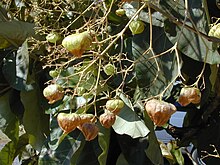Teak
Teak Tree Description and Botanical History:
– Teak is a large deciduous tree with greyish-brown branches, ovate-elliptic leaves, and globose fruit.
– Flowers are insect or wind-pollinated, and the wood has a hard texture with porous rings.
– First formally described by Carl Linnaeus the Younger in 1782, with variations identified by Harold Norman Moldenke in 1975.
– Different forms like canescens, pilosula, punctata, and tomentella have been identified.
– Teak is one of three species in the genus Tectona.
Teak Distribution and Habitat:
– Native to South and Southeast Asia, teak grows in habitats with varying rainfall from arid to moist forests.
– Typically found in areas with 1,250–1,650mm of annual rainfall, with genetic origins identified in India and Myanmar/Laos.
– Teak is adaptable to habitats with 500mm to 5,000mm of annual rainfall.
Teak Cultivation and Utilization:
– Teak’s natural oils make it useful in exposed locations and pest-resistant, mainly harvested from plantations in Indonesia.
– Concerns about old-growth teak depletion have led to sustainable plantation production in the seasonally dry tropics.
– Teak has been used in boatbuilding for over 2000 years due to its resistance to rot, fungi, and mildew.
Teak Propagation and Conservation:
– Mainly propagated from seeds, with germination involving seed pretreatment to remove dormancy.
– Clonal propagation techniques include grafting, stem cuttings, and micropropagation.
– Efforts are made to preserve teak groves, study genetic resources, and combat illegal logging for sustainable forestry.
Teak Research and Literature:
– Research focuses on teak silviculture, management, and genetic diversity analysis.
– Clonal propagation techniques have been developed, and literature provides insights into teak characteristics and uses.
– Teak bans have been implemented in Southeast Asian countries to protect this valuable natural resource.
Teak (Tectona grandis) is a tropical hardwood tree species in the family Lamiaceae. It is a large, deciduous tree that occurs in mixed hardwood forests. Tectona grandis has small, fragrant white flowers arranged in dense clusters (panicles) at the end of the branches. These flowers contain both types of reproductive organs (perfect flowers). The large, papery leaves of teak trees are often hairy on the lower surface. Teak wood has a leather-like smell when it is freshly milled and is particularly valued for its durability and water resistance. The wood is used for boat building, exterior construction, veneer, furniture, carving, turnings, and various small projects.
| Teak | |
|---|---|

| |
| Teak foliage and fruits | |
| Scientific classification | |
| Kingdom: | Plantae |
| Clade: | Tracheophytes |
| Clade: | Angiosperms |
| Clade: | Eudicots |
| Clade: | Asterids |
| Order: | Lamiales |
| Family: | Lamiaceae |
| Genus: | Tectona |
| Species: | T. grandis
|
| Binomial name | |
| Tectona grandis | |
| Synonyms | |
| |
Tectona grandis is native to south and southeast Asia, mainly Bangladesh, India, Indonesia, Malaysia, Myanmar, Thailand, and Sri Lanka, but is naturalised and cultivated in many countries in Africa and the Caribbean. Myanmar's teak forests account for nearly half of the world's naturally occurring teak. Molecular studies show that there are two centres of the genetic origin of teak: one in India and the other in Myanmar and Laos.

